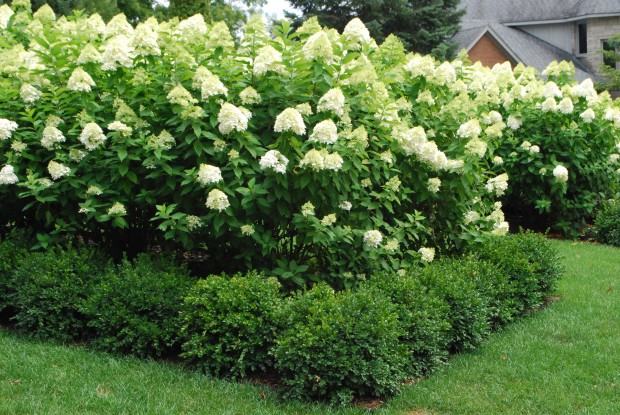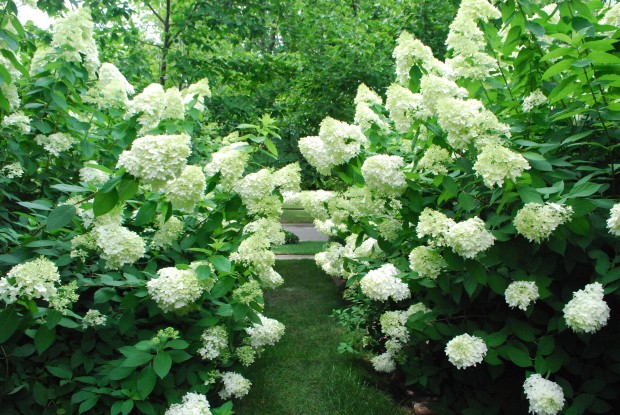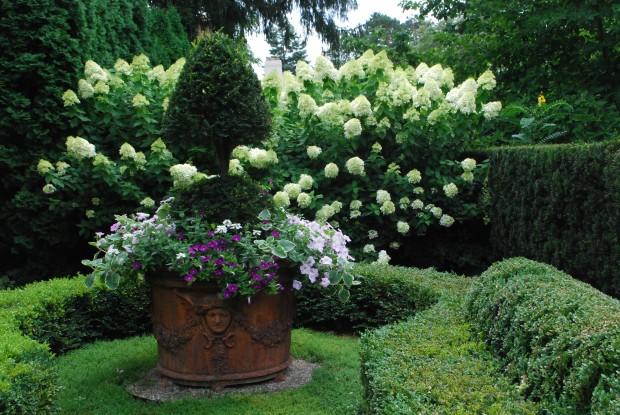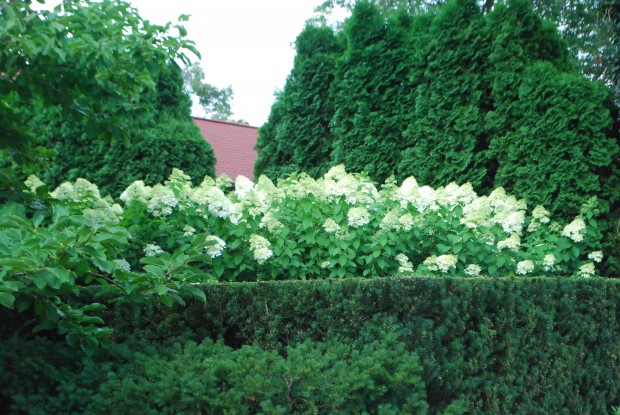Summer blooming hydrangeas appeal to almost every gardener. Each flower head is substantial. Comprised of hundreds of tiny florets, a single cut stem is a bouquet that celebrates the beauty of the summer season. One shrub in full bloom delights the eye. There are no end of cultivars-some white, some pink, some blue on occasion. They are broadly tolerant of a variety of conditions, but appreciate their fair share of sun, space, and water. I plant Limelight hydrangeas, and the new dwarf version, Little Lime, more than any other variety. They are vigorous growers, and bloom reliably.
My zone is a little too chilly and unfriendly for a good many hydrangeas. This is just me talking, but I only have one westside client who has been successful in growing blue hydrangeas. Her success is a mystery to me. The pink flowering varieties, available in my zone are easy to grow, but so reluctant to bloom. Sporadic bloom on a sizeable shrub makes me look like I don’t know how to garden. My clients on the east side of the metropolitan area have no problem cultivating pink and blue hydrangeas. I can’t help but think Lake St. Clair mitigates seasonal extremes.
I am satisfied to grow the hydrangeas that do well in my area. This means Annabelle,and Limelight. White hydrangeas, these. They are easy to grow, and so willing to bloom. Come June, the Annabelles delight every gardener with their snowballs. My favorite place to site them is on a slope, as they are stubbornly floppy in habit. Come the first of August, the Limelights transform the garden. 
Their greenish white conical flowers develope over a period of a few weeks. Chubby, luscious, and very large, the showy flowers dominate the summer landscape. I have 25 or 30 of them in the ground at our landscape yard. They are planted in gravelly soil, and make due with whatever water comes from the sky. They are a quarter of the size of these plants; the flowers are tufts. Plant hydrangeas in compost enriched soil that gets regular water.
Large growing hydrangeas can be stalky-leggy. Skillful pruning in the early spring can help keep them green and blooming to the ground. But a good underplanting gives them a very finished look. I like to face down most large growing shrubs with a smaller growing shrub or perennial. Boxwood does a great job of concealing those inevitably gawky Limelight legs. They do a better than great job of giving the hydrangeas some winter interes
This block of limelights is wedged in between a hedge of yews, and an L of boxwood. In a different, cooler, and more rainy summer, the tops of those yews would be dark emerald green, rather than the color of toast. But the lime green second flush of growth on the boxwood is a beautiful textural contrast to the hydrangeas. No legs on display here.
I prune my hydrangeas as soon as the buds swell in the spring. I give them a shag haircut, by shortening the long branches on the top. I rarely prune the bottoms. Heading back the long top branches allows light to reach the bottom. Good foliage and flowers requires good light. It is so easy to see in this picture that the heaviest bloom is occurring where there is the most exposure to light.
Limelights can be pruned as low as 24″-30″ in early spring. Hard pruning produces fewer, but larger flower heads. I prune my hydrangeas lightly, as I like them tall, and I like lots of flowers. They make a beautiful backdrop for this pot in August. They hydrate the look of my summer landscape.
My blocks of hydrangeas are sequestered behind a pair of yew hedges-one formally pruned, another left shaggy. Thuja nigra backs them up, and sets off the white flowers to good advantage. This is the juciest moment I have had to date in my garden all season-you bet I am enjoying them.








My relationship with my Annabelles is a love-hate one. They’re beautiful, and I get lots of compliments on them, but they require extensive staking to keep them from falling over. Once the flower heads are large, they hold a tremendous amount of water when it rains. The weight of the wet flower heads will cause the stems to permanently fall over unless they are staked.
Dear Alan, Annabelles need to be staked early on in the season. I like a double ring hoop-like for a peony-only 4′ tall. Bigger around than a peony hoop, and stronger than a tomato cage. Would that someone made such a thing! Deborah
I am loving my Limelights. They brighten up the front yard and they brighten me up.
The are a sight for sore eyes, aren’t they??
I have beautiful Limelights at my lake house. Two bushes that I planted 7 summers ago. They have been vigorous growers with very little care that produce massive flowers. I honestly never watered them besides when they were first planted. They took what they got from Mother Nature and thrived. I’m afraid the drought we are in (southern Illinois) has done some serious damage.. Only a couple of small blooms and even very few leaves left. I hope I haven’t lost them. I guess I won’t know until Spring.
Dear Pam, they are rugged, but severe and extended drought can damage them. I am hoping you get some rain, soon. Deborah
Dear Deborah,
well you know it, I also love the Limelights, always blooming very rich and they grow well in almost every soil and also here in north Italy, where summers are very very hot, and sometimes also very dry. I have to tell you that I have a new favorite Hydrangea,it is called Hydrangea Paniculata Magical Moonlight, has the same good characteristics as the Limelights but for me a better habit, and maybe even bigger and better flowers.The problem with the flopping Annabelle, could be solved by planting the “new improved annabelle”, called Incrediball, I have 2 in my garden and it seems really that the plants have stronger/sturdier branches, which avoid the staking…Greetings, Ciaooo Giacomo
Good to hear from you! And it’s good to hear your experience with hydrangeas. I don’t know Magical Moonlight-I will have to check it out. Thanks, Deborah
Deborah,
I just planted thirty Limelights on either side of my front yard and I want to plant a taxus x media Hicksii hedge in front of the Limelight hedge. How close is too close? I would like the Hicksii hedge to be about four feet high. I have VERY limited space but I am desperately attempting to hide the neighbor’s garish swing set.
xo
Andie
Dear Andie, the yews may not help so much with screening until they get very tall-and wide. Give as much room as possible between the limelights and the yews. Or take out three limelights, spaced 12-15 feet apart, and plant columnar trees that are very high branched-for screening up high. Deborah
“I prune my hydrangeas as soon as the buds swell in the spring.”
Does this statement mean you are cutting off buds? Do new buds form on these freshly pruned branches?
Regina, I am pruning back branches. Those branches probably have buds. Every place you prune, you will have new stem buds. You will have new leaf buds. These are different than flower buds. Hope this helps, Deborah
Thank you for your reply, Deborah. Yes, it helped!